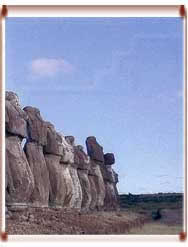Cultural Heritage of Easter Island, Chile
National implementing agency: Council of National Monuments, Chile
Project duration: August 2002 - August 2004
Total project budget: US$ 671,536
© UNESCO 2003
"The archaeological site of Easter Island (Rapa Nui), inscribed on the World Heritage List, bears witness to a unique cultural phenomenon: an ethnic group of Polynesian origin settled there in the 4th century BC, developing an original form of monumental sculpture and architecture free from external influences. From the 10th to the 16"' centuries, these people built shrines and erected enormous stone figures known as moai.
The project aims to improve the preventive conservation of the site and to study in depth the conservation problems of the Te Kito Pura and Tongariki moais. It also aims to draw up a conser-vation strategy to treat stone deterioration. At a workshop held on the island in August 2002, it was decided that priority would be given to preventive conservation and investigation, rather than to the restoration and reerection of the moais, and that there should be a strong emphasis on community participation in the conservation work."
(Extract from "Preservation of Tangible Cultural Heritage through the UNESCO/Japanese Funds-in-Trust" p.23)
Links:
Latest Publication on the International Cooperation through the UNESCO/Japanese Funds-in-Trust (
pdf, 2.91MB)
Second publication (2003) concerning the Japanese Funds-in-Trust Preservation of Cultural Heritage (
pdf, 2.29MB)
First publication concerning the Japanese Funds-in-Trust Preservation of Cultural Heritage (1998) (
pdf, 5.92MB)
Back to : The Japanese Funds-in-trust for the Preservation of World Cultural Heritage
Legal Matters | About Accessibility | Privacy Policy
Copyright : 2013 Permanent Delegation of Japan to UNESCO
